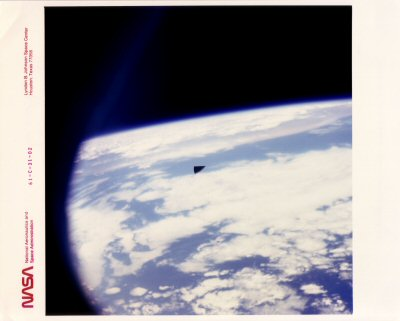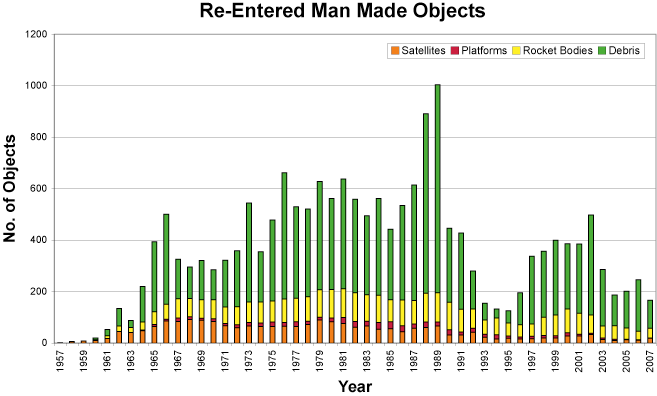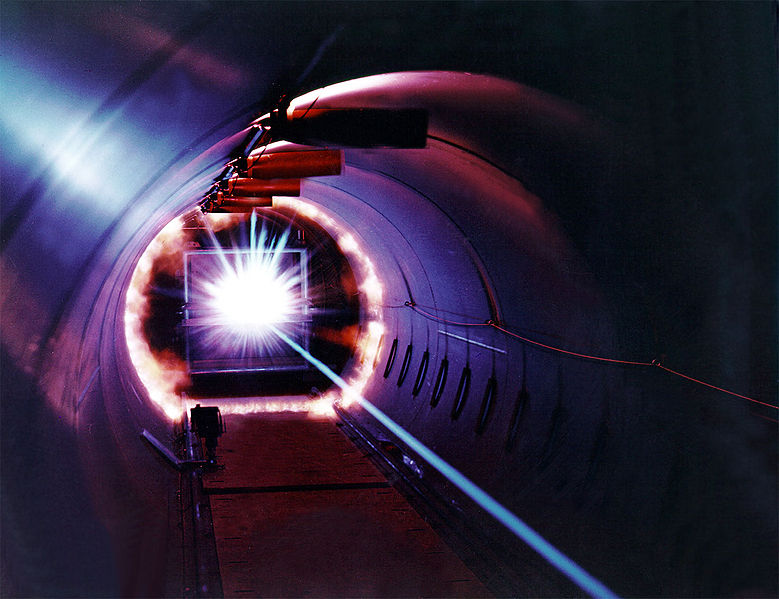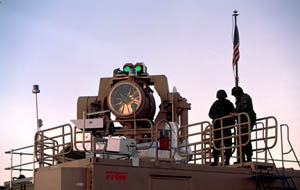
Insulation tile outside Columbia Shuttle in 1986
There are significant quantities of space trash in orbit. Estimates range from 23,000 to 26,000 items large enough to be tracked by radar, and in fact 95% of objects orbiting Earth are space junk (Donnelly, 3). Again, according to Donnelly, “500 to 1000 fall back to Earth each year and burn up in the atmosphere,” (52) but it takes longer than first expected, however. This graph illustrates this and is courtesy of the Center for Orbital and Reentry Debris Studies http://www.aero.org/capabilities/cords/index.html.

Johnson writes that “High-melting-point materials such as titanium, steel, ceramics, or large or densely constructed objects can survive atmospheric reentry to strike the earth's surface.” But even that said, “Most experts, including Jonathan McDowell of the Harvard-Smithsonian Center for Astrophysics in Massachusetts, US, see little to be concerned about. "Junk has been falling out of the sky for 40 years and at worst there have been a few cases of minor property damage," he told New Scientist.” The whole article can be found here: http://www.newscientist.com/article/dn13236. McDowell isn’t worried about space junk landing in a city because the percentage chance of getting hit by space debris is exceptionally low, but I maintain the point that space junk reentry (unlike end-of-lifecycle satellite reentry) is uncontrolled and there is still that chance.
Until only relatively recently, the orbits of space junk four inches and larger could be tracked. However, new radar systems can track trash the size of M&M’s. Tracking stations help alert space stations and satellites so that their orbit can be altered to avoid a crash. Thrusters are used to slightly change the orbit of the satellite or space station in order to do this. That said, the vast majority of space junk is unable to move (be it a decommissioned satellite, a wrench, or rocket staging) and prone to colliding into each other. In fact, “about 50 percent of all trackable objects are due to in-orbit explosion events (about 200) or collision events (less than 10)” (Gizimodo, 2). Each impact (particularly when rocket staging used to be over fueled and prone to explosion) drastically increases the number of man-made objects orbiting Earth. Shanks has an interesting term for this in “The Perfume of Garbage,” with something called “Kippleization” wherein useless things magically multiply when no one is looking. The scientific term for something like this is the Kessler Syndrome. As described by Wikipedia, it is:
“A scenario, proposed by NASA consultant Donald J. Kessler, in which the volume of space debris in Low Earth Orbit is so high that objects in orbit are frequently struck by debris, creating even more debris and a greater risk of further impacts. The implication of this scenario is that the escalating amount of debris in orbit could eventually render space exploration, and even the use of satellites, too prone to loss to be feasible for many generations.”
In other words, in a business as usual scenario, space junk will increase astronomically. On this note, Donnelly, writes that “an asteroid belt is forming between 200 and 700 miles above Earth (53).” This is obviously dangerous for all launches into space, man or unmanned, and makes space study difficult in terms of imaging, too.
Dangers in Space and on Earth
Space Junk is a serious problem: it can fall back to Earth and damage space stations or satellites. Space trash moves at thousands of miles per hour. If it were to hit a shuttle or a space station it could endanger astronauts. Shuttles routinely need maintenance where space junk has punctured layers of graphite fabric and underlying aluminum honey comb. It has been known to destroy other functioning satellites and cost millions of dollars in repairs. Wikipedia writes that “Clouds of very small particles may cause erosive damage, like sandblasting,” and these clouds are obviously the result of explosions. Rocket staging used to have fuel remaining in it and would be subject to blowing up as mentioned, but this was changed in 1981. Donnelly writes, “Space junk has landed in at least 12 countries. But more garbage by far is still orbiting Earth. Of this floating debris, approximately 45% is American and 47% is Soviet. An additional 7% belongs to the European Space Agency, India, China, and Japan” (73). I’ve included a few examples of space junk collisions:
Control
In “The Perfume of Garbage” article cited at the end of this paper, the authors write, “The report from the committee that investigated the tragic Discovery burn-up called for a complete revamping of the safety culture at NASA. Perhaps it is also time to look at NASA’s ‘garbage culture,’ or lack of it” (Shanks, 66). There have been extensive changes at NASA related to this in terms of designing missions to minimize waste launched into orbit. First, there was the movement to make sure all booster rocket fuel was used up by the time the proper orbiting altitude was reached. This lessened the effect of really intense explosions with space junk. Shuttles were also used for a long period of time until recently and they are able to return to Earth. There is finally a consciousness of the pollution problem in space because of the threats it poses to NASA’s missions, and therefore space junk is heavily monitored today by radar technologies. It has become an international effort in terms of radar technology, http://www.youtube.com/watch?v=8iRsaizBUaY, and in terms of policy with the formation of the Inter-Agency Space Debris Coordination Committee with policies that can be found here: http://www.iadc-online.org/.
There are also ideas about space junk remediation to reduce the overall quantities of trash far above us rather than simply reducing the rate at which it grows. The propositions I’ve read about all seem extremely expensive, however. One option is to retrieve space junk and bring it back to Earth in a shuttle, which seems both costly and inefficient as each launch to retrieve junk creates more junk. Another option is put satellites into a “graveyard” orbit farther out at the end of their lifecycle. Although this doesn’t directly address the space junk problem, and basically just pushes it away, if the satellites are beyond 25,000 miles from Earth, they’ll really only be an issue for radar tracking during long distance space trips to orbits around other planets or the moon, and they’ll also interfere with astronomical research. Another, seemingly far-fetched remediation technique is laser ablation—a theory proposed whereby space junk would be targeted by lasers on Earth which would super heat the material until it disintegrates into very, very small pieces. I couldn’t find much on this technology other than the idea that we have it in the form of the Tactical High Energy Laser (THEL) which has been used only to shoot down artillery to date. http://en.wikipedia.org/wiki/Mobile_Tactical_High-Energy_Laser. Basically, it seems as though little can be done about the growing problem of space trash aside from reducing the rate of space pollution and waiting for objects in LEO orbit to eventually be pulled back through Earth’s atmosphere.
 Hypervelocity Impact Range at NASA
Hypervelocity Impact Range at NASA
 THEL
THEL
